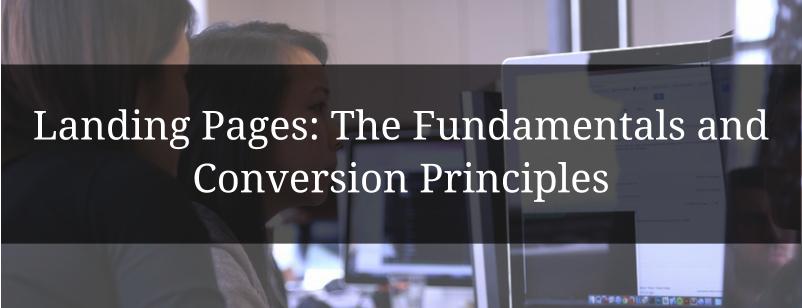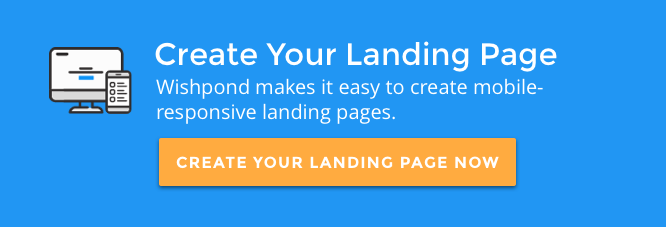Does your small business struggle for web conversions? Have you been putting time and energy into social media and online marketing but can’t quite figure out how to turn that energy into real-world money?
Have you created a landing page? Is it awesome? Does it convert?
This article will introduce you to landing pages; exactly what they are, why you need one, and the fundamentals of making one that results in sales.
But exactly, what is a landing page?
A landing page is precisely what it sounds like: the page within your website that internet users ‘land’ on when they traffic from any online source. It’s the next page an internet user will see after clicking on a link related to your business. This link could be a Facebook Ad, a Google search, a link on Twitter, a link within your blog, the list goes on and on.
The amount of landing pages your website has is entirely up to your business. Wishpond has somewhere between 35 and 50 (depending on webinars, promotions, ad campaigns, etc). You could achieve results with one.
The goal of a landing page is to encourage conversion within your sales funnel. It’s that simple.
I highly recommend a single Call to Action for landing pages. That action could be:
- Proceeding to checkout
- Submitting an email/lead generation
- Subscribing to an RSS feed
- Starting a free trial
- Creating an account
- etc, etc, etc.
Why does your business need a landing page?
Your business needs a landing page because they provide a focus point for your sales funnel
A landing page is what tells a visitor to your website how to act on their interest in your business.
It’s what turns a common internet user, window-shopping the web, into a guy on your shop floor, trying on shoes.
Let’s put the value of a landing page in concrete numbers. Landing pages facilitate conversions. Let’s say you’re an online retailer with 15,000 monthly site-visits. Your customers are spending, on average, $35 each time they buy. If your online site saw a conversion rate increase of 1% over that month, you’d see a $5,250 increase in revenue.
If you’re not sold, let me give you a case study that gives you a peek into your future:
In May, ski-resort holiday company Liftopia decided to test their landing page and see if they could optimize it. Using A/B testing website Optimizely.com
, they increased their revenue by 24% with the simple addition of a “Similar Products” option.
How do I create a landing page?
Creating a landing page is a straightforward process. Get in touch with your business’ web developer (or, in WordPress, do it yourself!). Create a new page (with the variables I’ve emphasized below), and start pushing web traffic towards it. You can also give a try to our landing page builder to create yours with no coding or developing skills required.
I recommend creating different landing pages for different sources of traffic. For instance:
- Create a landing page for each of your free ebooks, with a simple but effective two or three-box entry form (what we in the biz call ‘email-gating’ your content)
- Create a landing page for each of your business’ product genres (the individual tools you offer as a SaaS company; winter apparel or summer apparel)
- Create a landing page for each one of your ad campaigns based on what you’re promoting
- Create a contest landing page, directing traffic from a Facebook Ad
- Create a landing page within your existing website (like Liftopia did above). Any traffic that clicks on a certain link on your homepage gets sent to a landing page specific to that link. Make that page as focused as possible, because you already know exactly what they’re interested in.
How can I make a landing page that converts?
Wishpond’s Facebook Ads Tool landing page below collects traffic from many sources, blog articles, search, ads on Facebook and Google, whitepapers, our own website, and many more. Although we continue to test and optimize this landing page on a monthly basis, it’s a great example of a successful landing page that converts for our business.
1. Quick and Obvious USP:
Your USP (Unique Selling Point) is what sets your product or business apart from others. Your landing page needs to communicate this point immediately and obviously. Your USP can be communicated in multiple ways:
- The headline
- A supporting headline
- A value proposition
Your landing page’s USP, along with an image (see below) is what grabs the attention of a visitor. You have approximately 5 seconds to convince them the page (and your business) is worth looking into, and communicating the value of that investigation is how you do it.
USP and Value Proposition Ideas:
- The monetary value in terms they can understand
- The word Free – making the risk vs reward ratio ideal
- Positive comparison to a well-known brand
- State the expected ROI
- Offer success, either long-term or immediate
For more information on value propositions and USPs, check out my article 7 Value Proposition Formulas to Boost Conversion on Ads and Landing Pages.
2. Appealing Image or Graphic:
Images grab the attention of your landing page traffic. They also communicate ideas much easier than text. Have an attractive product or shop-front? Test including a picture of them in your landing page. This increases the visual appeal of the page and encourages your business’ reputation as personable.
I recently examined the psychology of images in advertising and discussed, in concrete terms, the astonishing effect of including pictures of people on your website and in landing pages and advertisements.
Adroll, one of the chief advertising re-targeting tools online, uses an image and video of its president Adam Berke to increase its landing page’s effectiveness below.
Test the effectiveness of an image for your own business’ audience. Your site-visitors may respond more to text, color or even an image of a beach than that of a person.
3. Solid Call-to-Action:
Your CTA is one of the most important variables within your landing page. I mentioned above that your landing page is what focuses an internet user’s attention where you want it. Your landing page’s CTA is the center of that focus. It gives them a single option for action. Making it clear, contrasting in color, and appealing is a vital part of a successful landing page.

While you may find success with multiple CTA’s on the same landing page, it’s essential that you have them traffic to the same end point.
Your landing page needs to have a single focus, as any distraction will increase the page’s bounce rate.
4. Short but Clear List of Benefits:
Providing 3-5 benefits is the second part of your page’s USP. Your headline and obvious value proposition grab their attention in less than 5 seconds. They decide to engage further, and it’s this short and obvious list of benefits that really sell them on your desired action.
Give the page visitor a little more information about who you are, what they’re in for, and what sets your business or product apart from competitors. I recommend sitting down and establishing the five selling points based around your business or product. Use the most appealing of these (I like dollar values) for your initial headline, subheader or value proposition. The next four write as single sentence (if not phrases) in list form.
I cannot emphasize ‘list form’ enough. It’s essential that this information be bullet-pointed or numbered, as any paragraphs on your landing page will reduce focus and increase your bounce rate.
5. Trust Symbol/Social Endorsement:
The simple addition of a trust symbol to a landing page has been known to increase conversions by 42%. Social endorsements work the same way by providing proof of the legitimacy of your product or business. People, especially social media users (where much of your landing page traffic will come from) value the word of their peers or a respected authority.
It was the addition of the symbol on the right which, quickly and easily, increased conversions by 42% and improved sign-up-form fill-outs by 81%.
6. Add Interactivity
Another incredibly effective way to boost landing page conversions is to turn static landing pages into more interactive ones. Instead of simply adding a link to a video, embed the video. Add animations, add audio content and make the landing page more engaging.
According to a webinar we ran with Brenna O’Neill, interactive landing page expert from Genially:
“Static pages and links make it very possible to lose your audience because they are going to leave your content. You might not get them back and they might miss out on the rest of the content that you have to share. We choose to focus on visual communication because the most important thing is what we see the most. This is thanks to interactivity, which is going to allow you to add a secondary layer of content. This means the user doesn’t have to seek out the content in order to view it.”
Watch the webinar below to learn more about using interactivity on your landing pages to increase conversions.
A/B Test
I won’t go into this too explicitly in this article, but it’s essential that you test your landing pages (a good landing page builder should have a tool built in to do this). The smallest variables (placement of your CTA, its color, the amount, size and font of the text you use, including an image/the type of image, and 1000 others) can mean huge changes in your landing page’s conversion.
These changes can result in thousands and thousands of dollars in real revenue for your business.
Conclusion
Hopefully you now have a solid grounding in landing pages. You know exactly what they are, how essential they are for your business, and the five most important variable best-practices you need to include.
Further reading:
- What is a Landing Page?
- Wishpond Landing Page Frequently Asked Questions
- 17 Landing Page Examples Reviewed with A/B Testing Ideas
- The Data-Driven Guide to Landing Page Design [Infographic]
- 25 Tips to Optimize Landing Page Conversions
- Landing Pages: Optimizing your Landing Page for Lead Generation
- 3 Examples of Landing Pages Optimized for Facebook Ad Traffic
- 5 Facebook Ad and Landing Page Combinations Critiqued
Have you recently started with landing pages and are excited by the success you’re seeing? Are you wondering about the best variables to optimize your landing page for conversions? Start the conversation below.


